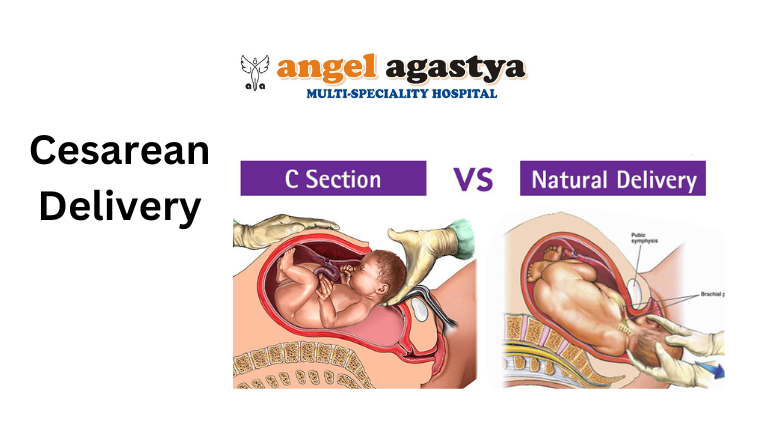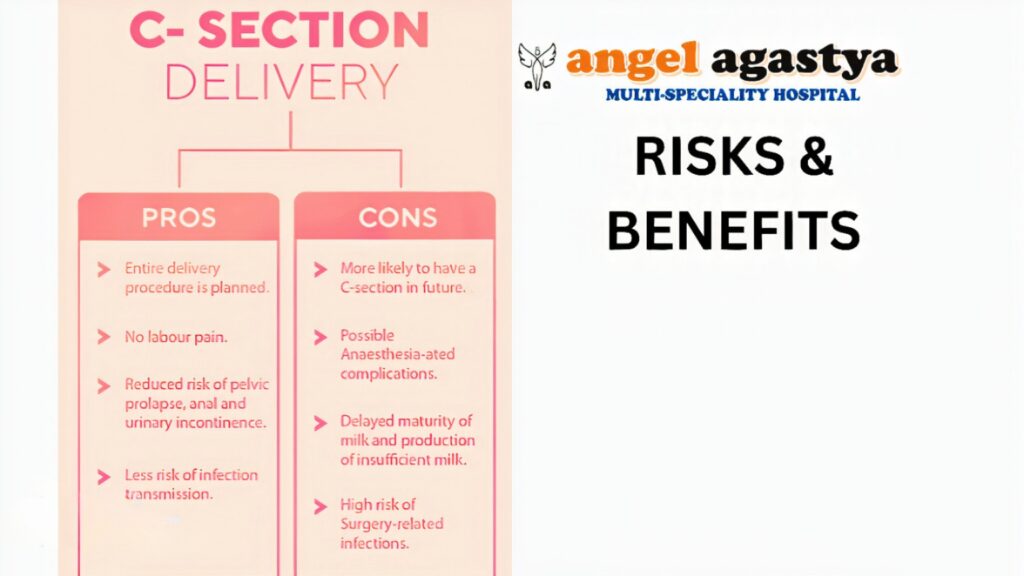I. Understanding Cesarean Deliveries
A. What is a Cesarean Delivery?
Cesarean Delivery is a process of giving birth to baby when the mother/woman is facing complications during labour and the baby is not able to come out naturally, so after doctor consultation the mother has to give birth through this process.

Definition and Purpose
A Cesarean delivery, or C-section, is a surgical procedure to deliver a baby via cuts in the mother’s abdomen and uterus, often due to medical concerns.
The purpose is to surgically deliver a baby when a vaginal/normal delivery seems risky to the mother or baby. To prevent injury and death in women facing complications in delivery.
When and why a cesarean delivery may be necessary?
A Cesarean delivery may be necessary when a normal birth is at risk, such as fetal pressure, breech presentation, placenta issues, previous C-section, or maternal health concerns. It is typically performed if the safety of the mother or baby is at risk during childbirth.
Risks and Benefits associated
Risks:
- Surgical complications
- Longer recovery
- Increased risk of infection
- Breathing issues for the baby
Benefits:
- Emergency intervention when complications arise
- Safer delivery in certain medical conditions
- Planned C-sections can be scheduled
- Reduced risk of pelvic floor damage for the mother

B. Different Types of Cesarean Deliveries
- Planned Cesarean Section
- Emergency Cesarean Section
- Classical Incision
- Low Transverse Incision
- Low Vertical Incision

Emergency versus Planned cesarean delivery
- Planned Section:
- Scheduled in advance for medical reasons.
- Provides a controlled environment for the surgery.
- Emergency Section:
- Unplanned, performed during labor.
- Addresses sudden complications endangering mother or baby.
The role of medical professionals during a cesarean delivery
The role of medical professionals is crucial:
- Obstetrician/Gynecologist (OB/GYN):
- Performs the surgery, makes cuts, and supervise the entire procedure.
- Anesthesiologist:
- Administers anesthesia to ensure the mother’s comfort and pain management during the surgery.
- Nurses and Surgical Team:
- Assists in preparing the operating room and provides support during the surgery.
- Pediatrician/Neonatologist:
- Attends to the newborn immediately after delivery, ensuring their well-being.
- Scrub Nurse/Circulating Nurse:
- Assists the surgeon by handing instruments and maintains a clean and hygienic environment.
- Midwife/Doula (if applicable):
- Provides emotional support to the mother before, during, and after the delivery.
- Medical Support Staff:
- Monitors necessary signs, control medications, and ensures overall patient safety.

Informed decision-making and involving the birth partner
Informed decision-making is crucial in childbirth, involving the birth partner enhances support:
- Information Gathering:
- Understand risks, benefits, and alternatives to make informed choices.
- Open Communication:
- Discuss concerns, preferences, and birthing options with healthcare providers.
- Birth Plan Collaboration:
- Involve the birth partner in creating a complete birth plan aligned with preferences.
- Supportive Presence:
- Birth partners provide emotional support during decision-making and throughout the birthing process.
- Advocacy Role:
- Birth partners support the mother’s choices during labor and delivery.
- Education and Preparation:
- Attend childbirth classes together to enhance understanding and readiness.
- Postpartum Involvement:
- Birth partners play a key role in postpartum care and recovery support.

C. Psychological Preparation for a Cesarean Delivery
Psychological preparation for a cesarean delivery involves acknowledging and addressing emotional concerns, promoting open communication with healthcare providers and a birth partner. Utilizing mindfulness techniques, seeking support, and gaining knowledge about the procedure contribute to a positive mindset, easing uncertainties for a smoother experience.
Addressing Fears and Concerns
Addressing fears and concerns about a cesarean delivery involves open communication with healthcare providers, seeking information about the procedure, and engaging in supportive discussions with the birth partner or counselor. Understanding the process and having a well-informed support system can help reduce anxiety and ensure a more confident approach to the upcoming delivery.

Understanding mental and emotional well-being during the process
Understanding mental and emotional well-being during the process of childbirth is essential. It involves acknowledging and addressing emotional aspects, practicing mindfulness techniques, and seeking support to promote a positive and strong mindset for a smoother experience.
Building a support system and seeking professional guidance
Building a support system and seeking professional guidance are essential steps in navigating challenges. Surrounding oneself with a supportive network of friends, family, and professionals contributes to emotional well-being and ensures a more informed and resilient approach to addressing various issues.
II. Preparing Physically for a Cesarean Delivery
Preparing physically for a cesarean delivery involves following preoperative instructions provided by healthcare professionals, from maintaining general health to overall well-being.
A. Prenatal Care and Consultations
Prenatal care and consultations are essential aspects of ensuring a healthy pregnancy. Regular check-ups with healthcare providers monitor the well-being of both the mother and the developing baby, providing necessary guidance and interventions to promote a successful and safe pregnancy.
B. Nutrition and Exercise
Maintaining a healthy pregnancy involves a balanced diet and regular exercise for the well-being of both the mother and baby. Sufficient rest is essential. Including core-strengthening exercises supports the birthing process and post-delivery recovery. This complete approach ensures a positive and healthy pregnancy experience.
C. Preoperative Preparation
Before the surgery, understanding the preoperative process is essential. Follow guidelines on eating and drinking before the surgery. Additionally, finalize childcare arrangements and attend to other practical matters to ensure a smooth and well-prepared preoperative experience.

Summary and FAQs
Summary:
The blog post covers various aspects of cesarean deliveries, from understanding the procedure and types to the role of medical professionals and psychological preparation. It highlights informed decision-making, involving birth partners, and addresses fears and concerns. The physical preparation section discusses pregnancy care, nutrition, exercise, and preoperative readiness for a positive childbirth experience.
Key Takeaways and Guidelines
Key Takeaways:
- Cesarean Delivery Definition
- Necessity Factors
- Risks and Benefits
- Types of Cesarean Deliveries
- Medical Professionals’ Roles
- Informed Decision-Making
- Psychological Preparation
- Physical Preparation
Guidelines:
- Communication is Key
- Holistic Approach
- Know Your Options
- Build a Support System
- Preparation is Key
FAQs:
- What is a Cesarean Delivery?
- A Cesarean Delivery is a surgical procedure for childbirth when complications during labor pose risks to the mother or baby, requiring surgical intervention.
- Why and when is a cesarean delivery necessary?
- Cesarean deliveries may be necessary when complications, such as fetal distress or breech presentation, make a vaginal birth risky for the mother or baby.
- What are the risks and benefits associated with cesarean deliveries?
- Risks include surgical complications and longer recovery, while benefits encompass emergency intervention and safer delivery in certain conditions.
- What are the different types of cesarean deliveries?
- Types include planned and emergency sections, with variations in incisions like classical, low transverse, and low vertical, each serving specific purposes.
- How can I prepare for a cesarean delivery, both physically and mentally?
- Physical preparation involves prenatal care, nutrition, exercise, and preoperative readiness. Psychological preparation focuses on acknowledging emotions, open communication, and seeking support from professionals and birth partners.
- Is it possible to have a birth plan for it?
- Discuss the importance of communication with healthcare providers and the flexibility needed in birth plans for cesarean deliveries.
- How long is the usual recovery time after it?
- Provide an overview of the typical recovery timeline, factors that can affect recovery, and strategies for promoting healing.
- Can I breastfeed immediately after it?
- Explain the benefits of early breastfeeding, techniques for comfortable positioning, and how to overcome challenges associated with breastfeeding after surgery.
- What should I expect during this procedure?
- Outline the steps involved in cesarean delivery, including anesthesia options, surgical procedures, and postoperative care.
- Are there risks associated with having multiple cesarean sections?
- Physical preparation involves prenatal care, nutrition, exercise, and preoperative readiness. Psychological preparation focuses on acknowledging emotions, open communication, and seeking support from professionals and birth partners.

Note:
Remember to consult with your healthcare provider for personalized advice and information tailored to your specific needs and circumstances.

It’s going to be end of mine day, except before finish I am reading this wonderful piece
of writing to improve my experience.
You coould certainly see your skills inn thee article you write.
The sctor hopes for even more passionate writers such as you who aren’t araid
to mention how they believe. All the time ggo after
your heart.
Youu could certainly see your skills in the article you write.
The sector hopes for even more passionate writers such as
you who aren’t afraid to mention how they believe.
All the time go after your heart.
Nice blog here! Also your web site loads up very fast!
What host are you using? Can I get your affiliate link to your
host? I wish my web site loaded up as fast as yours lol
Hostinger (https://www.hostinger.com/)